April 11, 2008
Air Date: April 11, 2008
FULL SHOW
SEGMENTS
Allergic Reaction to Climate Change
View the page for this story
Alaska used to be a great place to live if you have allergies – not much grows on tundra, so pollen counts are low. But with climate change, not only is tundra giving way to flora, but there are also some new insects moving in, insects that cause allergic reactions in humans. Host Bruce Gellerman talks with Jeffrey Demain, founder and director of the Alaska Allergy Asthma and Immunology Center, about how climate change will make more of us sneeze, and worse. (05:30)
Climate Bill Under Fire
/ Jeff YoungView the page for this story
The leading global warming bill in Congress is coming under fire from some who support action on climate change. Some environmental groups say the bill is too weak. And at least one candidate for president wants to make the bill boost nuclear power. Washington correspondent Jeff Young reports on the climate bill's steep climb up Capitol Hill. (06:10)
The Wolf and the Soul of the West
/ Sandy TolanView the page for this story
Sandy Tolan reports from New Mexico on the movement to reintroduce the Mexican wolf, or lobo, to the region. Tolan visits with ranchers who depend on cattle and see the wolf's return as a bad idea whose time ought never come, as well as others who believe in a holistic approach to living and ranching where wild wolves are once again part of the terrain. (16:48)
Living with the Lobo
View the page for this story
It’s been 13 years since we aired the award-winning story, The Wolf and the Soul of the West. Host Bruce Gellerman talks with rancher Jan Holder about techniques to keep wolves and cattle separate and how the ranching community has reacted to the re-introduction of wolves in Arizona. (03:45)
Heritage for Sale
View the page for this story
Privately held land is for sale inside 56 national parks. Ron Tipton from National Parks Conservation Association tells host Bruce Gellerman why the federal government has found willing sellers but can't afford to buy the private holdings in places like Zion National Park. (08:00)
Our Sound Environment
/ Bruce GellermanView the page for this story
On the campus of Tufts University an anthropologist and a composer have teamed up to create Harmony in the Age of Noise. It’s a new, interactive ,audio-installation designed empower our sense of hearing and train us to see with our ears. Living on Earth host Bruce Gellerman gets an earful from audio-artist Bruce Odland. (08:00)
Show Credits and Funders
Show Transcript
HOST: Bruce Gellerman
GUESTS: Jeffrey Demain, Jan Holder, Ron Tipton, Bruce Odland
REPORTERS: Jeff Young, Sandy Tolan
[THEME]
GELLERMAN: From Public Radio International – this is Living on Earth.
[THEME]
GELLERMAN: I’m Bruce Gellerman. Alaska is warming up faster than any other place on the planet – creating a climate that insects love…and people dread.
DEMAIN: We experienced our first two deaths in Alaska from yellow jacket stings in 2006, and when we started looking at this we found that there was about a ten-fold increase in the number of yellow jackets in Fairbanks.
GELLERMAN: Climate change, bugs that bite, and allergies that spread, as the far North defrosts.
Also, creating art from cacophony.
ODLAND: When you walk up to it, the whole world is tuned to the key of E. All the harmonics get regenerated and it makes a chord. Basically, Boston Avenue is playing a huge didgeridoo.
[SFX OF HARMONICS]
GELLERMAN: A new interactive artwork trains the ear to see. We watch and hear Harmony in the Age of Noise taking shape. These stories and more this week on Living on Earth. Stick around!
ANNOUNCER: Support for Living on Earth comes from the National Science Foundation and Stonyfield Farm.
[NEWSCAST]
Allergic Reaction to Climate Change

Aerial yellow jackets on a nest. (Photo: Jeffrey Demain)
[THEME RETURN]
GELLERMAN: From the Jennifer and Ted Stanley Studios in Somerville, Massachusetts – this is Living on Earth. I’m Bruce Gellerman, in for Steve Curwood.
The World Health Organization is celebrating its sixtieth birthday by warning that climate change is an urgent threat to Earth’s population. New diseases, old diseases in new places, excessive heat and more extreme natural disasters caused, in part, by climate disruption are harming our health, and in some cases – like Alaska – killing people. Alaska is on the front lines of global warming: over the last six decades temperatures there have risen four times as fast as the rest of the planet, escalating pollen counts and stings from insects.
We turn to Jeffrey Demain, founder and director of the Alaska Allergy, Asthma and Immunology Center in Anchorage. And Dr. Demain, welcome to Living on Earth.
DEMAIN: Thank you very much, it’s my pleasure to be here.

Yellow Jackets devour a bird. (Courtesy of Jeffrey Demain)
DEMAIN: Well, actually, we stay pretty busy throughout the state. Your comment is correct, we certainly have seen more intense pollen cycles, both in number of pollen levels as well as duration of the cycles over the past few years. I would say our tree pollen cycle has increased by three weeks, and the same with our grass pollen cycle.
GELLERMAN: What about stings from insects?
DEMAIN: Well, that’s a very interesting topic. This is an area that I’ve been researching for a little over a year. We experienced our first two deaths in Alaska from yellow jacket stings in 2006 – this occurred in Fairbanks. Well, that alerted our attention, so we started looking at why did this happen. What changed? And when we started looking at this we found that there was about a ten-fold increase in the number of yellow jackets in Fairbanks. A biologist captured several just on his property and estimated that he killed 12,000 yellow jackets just there alone.
We looked at the data from a hospital in Fairbanks and found that the number of people seeking medical attention in the emergency department for stings rose from approximately 40 a year to 178 a year. And when we took that back to between 1990 and 1994, there were actually zero occurrences. So, there was definitely a rise in Fairbanks.

Jeffrey Demain is the Director of the Allergy, Asthma & Immunology Center of Alaska.(Courtesy of Jeffrey Demain)
GELLERMAN: So, why are we seeing more stings and more cases of allergies in Alaska?
DEMAIN: Well, we’ve been following the changes in climate – now, changes in climate not only include temperature warming during the summer, but also higher winter temperatures – and that actually may be the more important one. But, in addition to that, with these temperatures and more precipitation, we’re seeing the migration of alpine tundra. So it’s actually disappearing, and it’s being recaptured by other flora and fauna, which is gonna create more grasslands, more forests, and actually, probably, relocate and redistribute certain insect species.
GELLERMAN: I was reading your research and you say that 90 percent of the tundra in Alaska is gonna be lost in the next hundred years?
DEMAIN: That’s what the prediction is. And a lot of these predications were made in 2001, and we’re – right now, just seven years later – we’re 30 years ahead of those predictions.
GELLERMAN: So, what does that mean in terms of allergies and insect bites going forward?

Yellow jackets on a nest. (Courtesy of Jeffrey Demain)
GELLERMAN: What are the medical implications of climate change you think we’ll see in the future?
DEMAIN: Well, I think, you know, you brought up allergies, and I do believe we’re gonna see an increase in severity of simple allergic rhinitis – which is actually very significant, and it affects people’s quality of life. Along with that, asthma occurs in at least a third of patients that have allergies, so I believe we’re gonna see intensification of asthma, especially patients that have pollen sensitivities.
We’re already seeing a significant impact with some of the redistribution of insects and people have allergic reactions and requiring more aggressive therapy for that. In fact, we’re now seeing fatal events as a result of it.
And I think beyond that – if you step back again a little further – we’re looking at, what else is impacted by climate change? There’s very, very, very good evidence that we’re seeing dramatic increases in malaria, dengue fever, viral encephalitis throughout the world, even as a close as Mexico and South America. And these are directly impacted by climate change. Even things like hantavirus in the southwestern United States, as well as plague in the southwestern United States –and West Nile virus – all of these are probably a reflection of shifts in the environment and shifts in climate.
GELLERMAN: Dr. Demain, thank you very much.
DEMAIN: You’re very welcome and it was my pleasure.
GELLERMAN: Dr. Jeffrey Demain is founder and director of the Alaska Allergy, Asthma and Immunology Center in Anchorage.
Climate Bill Under Fire
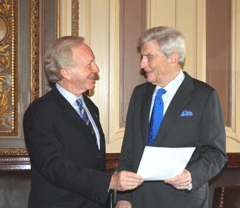
Senators Lieberman and Warner drafted this session's climate change bill. (Courtesy of the U.S. Congress)
GELLERMAN: This June, the U.S. Senate is slated to vote on a major global warming bill designed to cut greenhouse gas emissions. The bill relies on a cap and trade system to limit carbon dioxide, and its lead sponsors in the Senate – Independent Joe Lieberman and Republican John Warner – say they’re picking up more and more supporters. But the opposition is also growing – even some lawmakers who say they want to see action on climate change don’t like this bill. So, as Living on Earth’s Jeff Young reports, the legislation faces a steep climb up Capitol Hill.
YOUNG: Virginia’s stately Senator John Warner is stepping down after 30 years in office. Before retiring to his prize-winning sunflower garden he has one last item on his to-do list, and it’s a doozy: cutting the country’s greenhouse gases.
His bill aims to reduce carbon dioxide emissions from across the economy so that by mid-century the U.S. would put out about 70 percent less CO2 than it did in 1990. Warner’s Senate colleagues want to know what that’s going to cost.
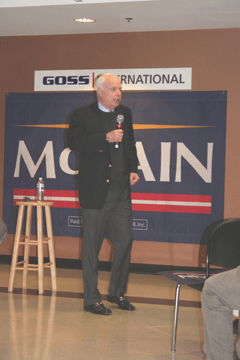
Senator and presidential candidate John McCain wants the Lieberman-Warner climate bill to provide support for nuclear power. (Photo: Jennifer Stevens)
YOUNG: Warner’s bill has a lot of provisions to soften the blow: things like assistance for low-income consumers and home energy efficiency programs. And the bill’s cap and trade system would allow companies to buy and sell the rights to emit CO2. That’s generally viewed as a market-friendly approach. Warner’s partner, Connecticut’s Joe Lieberman, says that the trading system will have independent oversight to avoid the mistakes that made Europe’s carbon trade open to market manipulation.
LIEBERMAN: This is very important and it will involve a lot of money. And there was some profiteering and speculating in early European experience, which we don’t want to have happen here.
YOUNG: The bill faces stiff opposition from the National Chamber of Commerce and Manufacturers Association, who say the carbon cap will cost too much and kill jobs. Lieberman says economic analysis shows the bill’s costs are manageable. And he says Senate support for the bill is getting close to 60 – that’s the magic number needed to overcome a filibuster in the Senate. However, as he left a recent press conference, Lieberman told me that he does not yet have the support of one of his closest climate allies in the Senate – the man he supports for president – John McCain.
YOUNG (to Lieberman): You think you’re near 60 votes. Do you happen to know is Senator McCain among them?
LIEBERMAN: He has a single issue, which we’ve talked about, which is to include some support for nuclear energy as a solution to the global warming problem. We’re working on such language. I’m totally confident that we will have an agreement, and that Senator McCain will support this legislation, because he’s been a leader in the battle to do something about global warming here in
Washington.
YOUNG: But he’s not yet firmly in the aye column?
LIEBERMAN: (chuckles) I think I gotta leave the exact answer to him. I can tell you this – he really wants to vote for this legislation.
YOUNG: McCain is a vocal proponent of nuclear power, as he told New Hampshire voters on the campaign trail in January.
MCCAIN: One of the tings I think we need to do is expand and reemphasize the need for nuclear power. I believe that nuclear power works. I believe that it is viable.
YOUNG: A nuclear power provision in the global warming bill would bring McCain on board, but it could cause others to jump ship. McCain and Lieberman partnered on another climate bill three years ago. When they added to it subsidies for nuclear power, they lost the support of four Senators and the major environmental groups.
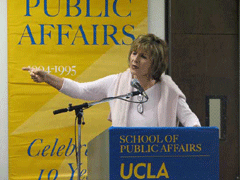
Senator Barbara Boxer chairs the Senate Environment and Public Works Committee. (Courtesy of U.S. Congress)
POPE: Oh, I have a wonderful nuclear amendment I would really like to see; I would like a nuclear amendment that says ‘anybody who wants to build a nuclear power plant will do it with their own money, instead of yours and mine.’ The first man who comes into my office and says ‘I want to build a nuclear power plant with my own shareholder’s money,’ I will give him a big hug and I will say, ‘God bless you, they must have a lot!’
YOUNG: Pope and about a dozen other environmental leaders recently lined up behind California’s Democratic Senator Barbara Boxer at a press event. Boxer’s made passing the Warner-Lieberman bill her top priority as chair of the Senate’s environment committee, and she wanted a strong show of support.
BOXER: I think there are rumors circulating that the environmentalists are all over the map on this. That is not true. The environmental organizations are united. They want a necessary strong bill.
YOUNG: But some environmental groups oppose the bill. The group Friends of the Earth ran ads attacking Warner-Lieberman for giving away carbon emission permits to the coal power industry instead of auctioning them off. Greenpeace executive director John Passacantando says the bill would not achieve the cuts in greenhouse gases that most climate scientists say are needed.

Senators Lieberman and Warner drafted what they hope will become America's Climate Security Act. (Courtesy of the U.S. Congress)
YOUNG: So the leading global warming bill faces grumbling from some green groups, big money opposition from industry and a president who would likely veto it even if it passes. Despite all that, Warner, Lieberman and Boxer say they will soldier on. Even if the bill falls short, Boxer says they will at least know the score.
BOXER: You know, if we fall short of 60, if the bill gets, you know 58, we’ll know who those two people are. And we’ve got eighty percent of the people in America want a strong global warming bill. So, we’re gonna play hardball with this. Hardball – because this is about saving the planet.
YOUNG: Hardball season begins June the second – that’s when the Warner-Lieberman bill is scheduled to hit the Senate floor for debate.
For Living on Earth, I’m Jeff Young in Washington.
Related links:
- To read the Climate Security Act, click here
- The Friends of the Earth campaign against Warner-Lieberman
- Read the Sierra Club statement on the bill
-
[MUSIC: DJ Logic/Jason Miles “Exotic Thoughts” from Global Noise (Shanachie Records – 2008)]
GELLERMAN: Coming up – who’s afraid of the big bad wolf? Well, plenty of ranchers out West, but maybe it’s the wolf who should be fearful. Keep listening to Living on Earth.
The Wolf and the Soul of the West
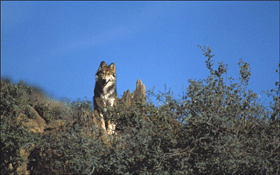
A Mexican Wolf on a cloudless Southwest day. (Courtesy of the U.S. Fish and Wildlife Service)
GELLERMAN: It’s Living on Earth. I’m Bruce Gellerman. April 22nd is Earth Day. It’s when we commemorate the birth of the modern environmental movement. In recognition, throughout the month of April, Living on Earth is re-broadcasting and updating some of our favorite, award-winning stories from years past. This week, we go back to 1995 and a story by reporter Sandy Tolan.
[WOLVES HOWLING, DOG BARKING]
GELLERMAN: Long before manifest destiny brought frontier settlers westward, before the Spaniards, before even the Apache and the Navajo and the Hopi, wolves roamed the arid southwest.
[WOLVES HOWLING]
GELLERMAN: But with the arrival of cowboys, cattle, and commerce, wolves were perceived as threats – predators to be destroyed. By the 1920s, federal bounty hunters had nearly exterminated wolves from the western landscape.
Yet in the mid-1990’s when Sandy Tolan produced our story, wolves were making a comeback in parts of the country. And the U.S. Fish and Wildlife Service that had been paying people to kill them 50 years earlier was planning to reintroduce them into the wilderness of Arizona and New Mexico.
This change of federal policy reflected changing public attitudes – but only for some, as Sandy Tolan learned. Here’s his story.
(“Wolves in the West” – Broadcast October 27, 1995)
[MUSIC: "With my rope and my saddle and my horse and
my gun, I'm a happy cowboy..."]
TOLAN: The cow lies butchered and quartered under a tarp in the flat bed of Jim Cook's pickup. It's a gray day with bite in the air. Cook flicks Marlboro ash out the window, squeezes the wheel with one hand.
COOK: In 60 days we'll have snow on the ground. Keep riding that horse with snowflakes falling, wondering what am I doing here?
[MUSIC: "And I love to hit the leather in any kind of weather, and I know I'll never change. With my horse and ... "; TRUCK ENGINE]
TOLAN: The cowboys and their herds cover the land here in Catron County on the western edge of New Mexico. Cows outnumber people ten to one. They graze millions of acres of public lands, and cowboys like Jim Cook, foreman of the Pueblo Creek Ranch, have spent a long time trying to make the land safe for cows. In Catron County, wolves are not welcome.
COOK: We've got to contend with bear. We've got to contend with lions. We've got to contend with coyotes. The last thing we need's another predator. I don't know where the idea that we have to have wolves back in the forest or back in the wilderness or whatever. Our forefathers spent a lot of time and a lot of money and energy exterminating them because of what they were. I don't see any reason to ever bring them back. I think they belong in a zoo someplace; people want to look at them, they can go look at them.
[A MOTOR STOPS. A DOOR SLAMS. PAPER RUSTLES.]
MAN: Butcher it this morning?
COOK: No, yesterday evening. Split it this morning.
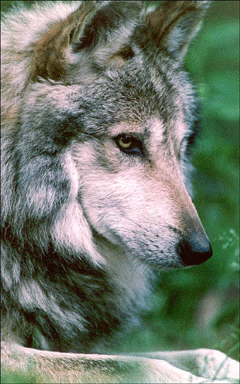
A male Mexican Wolf (Courtesy of the U.S. Fish and Wildlife Service)
COOK: Hind quarter?
MAN: The front.
COOK: Front.
[COOK GRUNTS AS HE HAULS MEAT; MEAT THUDS ONTO SCALE]
TOLAN: Then they're hauled into the cooler.
MAN: Just throw it on the floor (Laughs).
[DOOR CREAKS OPEN; METAL CLANKS]
TOLAN: Next to an elk hanging from a hook, a bear's head stares out from a box on the floor.
COOK: All right. It's a nice bear. Big ol' foot.
TOLAN: Reducing animals to harmless fur and meat, that's the custom here. Few people tell romantic stories about bears or mountain lions or wolves. Especially not when the Federal government comes down to the County seat to introduce its plan to put the Mexican wolves, or the lobo, back into the wilderness just west of here.
MAN: They've completely romanticized the wolf but, you know, we can't make decisions based on this Disney emotion. And wolves do eat Bambi, you know? And they pull Bambi down and rip him open and start eating his liver before his heart stops beating.
MAN: We had lobos down there when I was growing up. The most devastating animal that ever crossed the border. And being such a natural killer not only for what it eats, but just for the joy of killing. And here they are today trying to reintroduce it and I just can't understand it.
MAN: Well, I'm just like Jim – I don't, I can't see why they want to turn them loose.
MAN: Oh, they want things to go back to the nature, like what it was before the white man got here. And if they're going to release that wolf they ought to release some Indians down here and some buffalo, and put these gringos across that ocean back where they belong. That's where it's coming from (Laughs).
TOLAN: Standing here, you can understand how the lobo was nearly exterminated in the twenties, and you might wonder why anyone would bother trying to bring them back. But the men of Catron County, like ranchers across the Southwest, are now outflanked by city dwellers with different values.
BROWN: The land is not the same as it was 50 years ago. We have to recognize that time goes on, that things change, that there are more people, there's less wild land to use for everybody. And so we all have to make adjustments.
TOLAN: Pamela Brown has ventured to the hearings in Catron County from her home in Santa Fe. She teaches grade schoolers about the value of wolves in the wild.
BROWN: The general public in large percentage is very much for the return of wolves. I think that's the result of a changing feeling nationally and around the world. A more conscious attitude that wilderness supports us all. And that we need to take that into consideration and not see ourselves as the dominant life form here, but rather just one that's connected to everything else.
[HIGHWAY TRAFFIC; HORNS; WOMON ON RADIO: “GOOD MORNING AGAIN, WE ARE LOOKING GOOD, HEADING TOWARDS 7:30 WITH NO SERIOUS WRECKS REPORTED. INTERSTATE…”]
TOLAN: For 100 years the cowboy way dominated politics in the west. But as people have come in in big numbers to Albuquerque and Tucson and Phoenix, new values have come in with them. Just south of Catron County, Silver City, old home of Billy the Kid, has grown by nearly a quarter in just five years. Now, right around the corner form the old Buffalo Bar, you'll find the Espresso Bar.
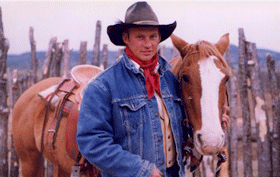
Will Holder with a horse on his ranch in Arizona (Courtesy of Jan Holder)
WOMAN: At Air Espresso we serve the regular espresso, plus lattes, cappuccinos, mochas. We do iced drinks...
SALMON: Yeah, it's a new kind of person coming in. There's a lot of retirees, but there's also a lot of younger people who are bringing their money and their lifestyle from someplace else.
WOMAN: We serve biscotti, which is an Italian cookie...
SALMON: Those kind of people tend to be wilderness lovers. They tend to be more environmental than the old timers who have been here a long time.
TOLAN: Dutch Salmon is publisher of High Lonesome books in Silver City, and author of “Home is the River,” a novel about placing wolves back in the wild.
SALMON: Urban people tend to view wildlife differently than rural people. As you get urbanized you yearn for the great outdoors, and you have this ongoing need for wildlife and wilderness and so forth. And you want to see it preserved. And so, naturally, they're going to want to bring the wolf back as a kind of aesthetic symbol. And since they're not raising any livestock it's no skin off their nose as to what these things eat. It's kind of an armchair fantasy. But that doesn't mean it's irrelevant or illegitimate. Urban people need some connection with the natural world, and if knowing there's a few wolves out there makes them feel better that's all to the good.
RUSSELL: Most people won't ever see wolves, and although they'd like to imagine they could hear the howl most will never hear the howl of a wolf. But that doesn't matter.
TOLAN: Charmin Apt Russell longs to hear the howl from her home outside of Silver City. She's the author of the book “Kill the Cowboy.”
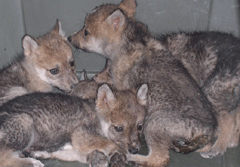
A litter of Mexican Wolf pups (Courtesy of the U.S. Fish and Wildlife Service)
TOLAN: This ethic emerged not simply through shifting demographics, but through an overall change in values away from the doctrine of eradication and control.
RUSSELL: There's a whole visceral thing about hunting and protecting your land. And I think of just taming the land, you know, of making it safe for cows. In my family I have great uncles who were big lion hunters, and they were the Lee Brothers. And you know, there is just this whole masculine thing about hunting down another predator and of killing them and eradicating them. I think there is a shift in how we see the natural world. There has to be a shift of controlling the world and taming the world and the poison and moving streams around, and just that control: I can control it. What's happened is that science has shown us that's not true. When we try and control those things, sometimes, we destroy them.
TOLAN: But the old-line ranching values are hanging on for dear life.
MAN: But it's not about putting wolves out here, and wolves surviving or being part of the balance of nature. It's about land control.
TOLAN: At a Stop the Wolf Barbecue up in Catron County, people say it's outsiders who are out to control and destroy. The government trying to control people's lives with more and more regulations. The environmentalists trying to destroy local culture and run ranching families off the land.
SCHNEBURGER: We've got a big crosshair on us and we know it.
TOLAN: Al Schneburger runs the New Mexico Cattle Growers Association.
SCHNEBURGER: Their vision is to crowd people into cities and force people off the land so that they'll be room for these large carnivores. And what they're talking about is crowding people into pretty small areas. I think they kind of envision it as, you know, the little George Jetson city where everybody rides a bicycle and it's all done with little walkways that move and everything. But the rest of it is just wild. It's the land control; the wolves are really almost a side issue. It's the control by the government; it's about, you know, bringing wolves in to school kids and indoctrinating school children into complex issues that adults can't even agree on. It's by using those kinds of tactics. We know what these people are about and we know what it all means, and it's just one more step to the destruction of our community and our society, and we're well on the way.
[WIND CHIMES]
TOLAN: Chimes call out from a front porch on an Arizona ranch, just across the border form Catron County. Sunflowers and yellow asters slope through the valley below. Cottonwoods and sycamores snake along a riverbed. This porch stands on middle ground. It's lonely ground staked out by a pair of young ranchers, Will and Jan Holder. Lonely ground, but pretty.
J. HOLDER: I'm looking out over Bear Canyon. It's been pretty over-grazed over the years and there's a lot of rock showing through, but there's still quite a bit of trees. A lot of rolling hills out beyond it.
W. HOLDER: There's about, you see the 20 elk, there's about 20 elk out there now. You can see the whole herd.
TOLAN: Just beyond the elk stands the blue range where the wolves are likely to be reintroduced. Will is third-generation rancher here. For a while, he and Jan were doing time in advertising jobs in Phoenix, until Jan says she was nearly ready to climb a skyscraper with an uzi. They moved back to the ranch but with a different philosophy: to ranch holistically, in tune with the entire ecosystem, and that means predators.
W. HOLDER: We'd like wolves reintroduced onto the ranch. Wolves are part of the ecosystem, part of the biodiversity. The wolf plays a very important part of this whole scheme of things.
TOLAN: Their neighbors think they're crazy, fly by night. But they're tied here, now. Last year they lost a baby girl in childbirth. They scattered her ashes on the ranch. Today, the memory of Will's grandfather, from a different time, a different ethic, lives on in the name of their new baby boy.
W. HOLDER: My grandfather, Cleve, the one we named our son after, was credited as shooting the last gray wolf off the Muggyon Rim. So that was, we'd like to be the generation that reintroduces the wolves back to Arizona.
J. HOLDER: Every time I see an elk, every time I see an antelope, every time I look out and see the coyotes at night or hear them howling, I just think it's just magic that this still exists. And I think we have to fight really hard all the time to keep this way of life and to keep animals alive in the wild. It seems like these pockets of wildness are just getting smaller and smaller and smaller. And I think we have to fight to keep them, or we won't ever hear a coyote howl or a wolf howl, anywhere.
W. HOLDER: I've only heard a wolf once, and that wasn't a wild wolf. There's a guy that has wolves he rents out for movies. I'd really like to hear one. I'm afraid we won't hear one. I'm afraid -- I'm afraid the whole project is just not going to work.

A Mexican Wolf on a cloudless Southwest day. (Courtesy of the U.S. Fish and Wildlife Service)
[CRICKETS AT SUNDOWN; A GUN CARTRIDGE IS PULLED]
TOLAN: On the other side of the Blue Range, dusk, back at the Pueblo Creek Ranch. Two young men stake out a coyote.
GREINSTEFF: I'm Jason Greinsteff.
PENDLETON: I'm George Pendleton.
TOLAN: This is not a wolf stakeout. Jason and George say they wouldn't do that. But the hunt is in their blood; it's part of their culture. Last year Jason and his high school buddies raised money for their senior trip by shooting coyotes and selling the pelts. Now they crouch, poised in the juniper bushes, watching the bait they've laid out, the guts from this morning's butchered cow.
GREINSTEFF: We kind of set them in the clearing so we can draw them out of the brush. See, right now, they're in the trees in the forest up there and we're trying to pull them down off that ridge right there. The coyotes off the ridge. We're trying to bring them down to this opening so we can get a better shot at them.
[RECORDED RABBIT CALLS]
TOLAN: And from their pickup truck comes the recorded call of a wounded rabbit. The young men are still. In the pale, fading light, a coyote appears from behind a juniper bush. Skinny and alert, he sniffs the air. Jason draws a bead with his Remington 30 ought 6.
[GUNSHOT]
TOLAN: He misses. Then he whistles. The animal stops one last time and stares back.
[GUNSHOT]
TOLAN: Jason misses again.
GREINSTEFF: He come right down through that clearing, and I had a good shot at him. I just missed him (Laughs).
TOLAN: And now, darkness envelops the hills. The coyote has disappeared into the forest, perhaps to appear again. And across the Southwest, in large holding areas hidden from human sight, the Mexican gray wolf paces endlessly in captivity. Like the coyote, who's had his narrow brush with death, the destiny of the lobo is unknown.
MAN: Wolves and men do not get along well, under any circumstances.
MAN: When I think or see a wolf, the quickest thing I want to do is get my gun and kill him. He just doesn't belong here.
WOMAN: There could be some ugly times, you know. But I think if we can all stick in this long term, I think that we're going to see that we can all live together, and I just really hope that both ends of this argument can just calm down long enough to give it a chance.
[A WOLF HOWLS]
TOLAN: For Living on Earth, this is Sandy Tolan reporting.
GELLERMAN: Our story about the reintroduction of wolves into the Southwest won reporter Sandy Tolan a Silver Reel Award from the National Federation of Community Broadcasters, and a Gold Cindy from the International Association of Audio-Visual Communicators.
[MUSIC: R Carlos Nakai, William Eaton & Will Clipman “Sonoran Twilight” from Red Wind (Canyon Records 2002)]
GELLERMAN: Just ahead, a dozen years after Sandy’s story first aired, we get an update from the rancher whose opinion welcoming the wolf back to Arizona earned her the animosity of her neighbors.
HOLDER: I think there has been a few people that have changed their minds. There has been a few people that I’ve spoken to that have felt that the wolves, instead of being the monster that they were expecting, were just one more predator – in the end they felt it was something they could live with and maybe even make money from.
GELLERMAN: That and more – stay tuned to Living on Earth.
ANNOUNCER: Support for the environmental health desk at Living on Earth comes from the Cedar Tree Foundation. Support also comes from the Richard and Rhoda Goldman Fund for coverage of population and the environment. This is Living on Earth on PRI, Public Radio International.
Living with the Lobo
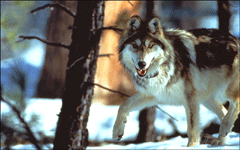
A Mexican Wolf in a pre-release pen (Courtesy of the U.S. Fish and Wildlife Service)
GELLERMAN: It’s Living on Earth, I’m Bruce Gellerman. And now an update to Sandy Tolan’s story about wolves. Jan and Will Holder, the ranchers in our story who were in favor of reintroducing the wolf into Arizona, were lone voices in the wilderness. Most of their neighbors were strongly opposed to the plan. Jan Holder joins us from a studio in Tucson, Arizona, the city she now calls home because the Holders no longer live on their remote ranch.
HOLDER: We had to take the vast majority of our cattle off because of the extended drought in Arizona.
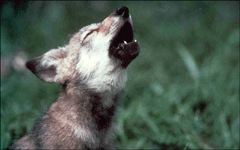
A Mexican Wolf pup practices howling (Courtesy of the U.S. Fish and Wildlife Service)
HOLDER: Absolutely not.
GELLERMAN: The U.S. Fish and Wildlife Service was able to reintroduce wolves with great success in the Great Lakes area and in the Rocky Moutains. In fact, they were being taken off the endangered species list. But they haven’t done very well in the Southwest. I guess there were just, what, eleven introduced; there are only about 50 now. And they say they need at least 100 to make a sustainable population.
HOLDER: I believe that’s true. I know that they’ve had a lot of problems. We’ve made a lot of mistakes, I think, with the wolf reintroduction.
GELLERMAN: What do you mean?

Jan Holder has been a rancher in Bear Canyon, Arizona. She and her husband halted ranching due to a drought but hope to return as soon as they can. (Courtesy of Jan Holder)
GELLERMAN: Because I heard, there was, the Defenders of Wildlife had been reimbursing ranchers for cows that were attacked by wolves.
HOLDER: Absolutely. But Defenders of Wildlife is a private, non-profit organization, and it’s taken them a long time to get people to gain acceptance for the ideas that we’re talking about.
GELLERMAN: Jan, what were some of the techniques that they were using?
HOLDER: Well some of them are as low-tech as being around your cattle a lot. Defenders of Wildlife is now, I know, paying for herders. Most of the people that are out there ranching on public lands – you’re talking about huge tracts of land – and most of the people just didn’t see their cattle very often. With the Defenders of Wildlife paying for herders, that means that the cattle are moved around a whole lot more often, and that that human presence is there all the time. It’s a real low-tech thing but human presence means a lot.
Some of the other things that they were paying for is, uh, a technique that they call fladry, which is basically just flagging that’s attached to fencing. And it’s something, the wolves don’t know what it is. It doesn’t last forever because after a while they’re smart enough to get used to it, but especially during a short period, like when you’re calving, it can really be effective.

A Mexican Wolf in a pre-release pen (Courtesy of the U.S. Fish and Wildlife Service)
HOLDER: Oh, absolutely. But I think there has been a few people that have changed their minds. There has been a few people that I’ve spoken to that have felt that the wolves, instead of being the monster that they were expecting, were just one more predator. Yes, it caused them more work, a little bit more time, but in the end they felt it was something they could live with and maybe even make some money from.
GELLERMAN: Jan, how can people make money from wolves?
HOLDER: Well, there’s a lot of people that want a chance to see a Mexican gray wolf. We booked every weekend that we had available for people to come out and see wolf country. And we made an awful lot of money off of it – especially when cattle prices were down and we weren’t making much money on the ranch.
GELLERMAN: Well Jan, thank you very much.
HOLDER: Thank you.
GELLERMAN: Former rancher Jan Holder, looking forward to the day she can go back to her home on the range.
Related link:
The US Fish and Wildlife Service Mexican Wolf Recovery Program
Heritage for Sale
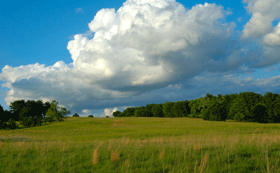
Valley Forge National Park. Developers want to build a hotel, museum, and conference center on private land inside the park. (Courtesy of NPCA)
[HOOFBEATS]
GELLERMAN: Listen my children and you shall hear…a reenactment of the midnight ride of Paul Revere.
[MAN SHOUTS: THE REGULARS ARE OUT; HOOFBEATS; MAN SAYS, “HALT, SIR, WHO ARE YOU AND WHAT IS YOUR BUSINESS?” MAN REPLIES, “REVERE, MY NAME’S REVERE, AND I COME WITH URGENT NEWS…]
GELLERMAN: Patriot Paul Revere’s hurry of hoofs in a village street is revered to this day, and a scene reenacted each year. But who remembers why the British troops were marching from Boston to Concord, Massachusetts, in the first place? Turns out, Red Coat spies had learned that there were massive amount of munitions hidden on James Barrett’s Farm in Concord. The shot heard round the world that marked the beginning of the American Revolution actually took place a mile and a half away, at North Bridge, on land now protected by the federal government as the Minute Man National Historical Park.
But Barrett’s farm, which played such a pivotal part of in the nation’s history, isn’t part of the National Park – at least not yet. It’s one of 55 sites the National Parks Conservation Association hopes to integrate into the federal system.
Ron Tipton is senior vice president of the organization, which just released a report, “America’s Heritage for Sale.” And Mr. Tipton, why isn’t Barrett’s farm part of the Minute Man National Park?
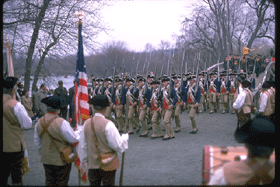
Actors reenact the Revolutionary War at Minute Man National Park in Massachusetts. The federal government owns the site where the revolution began but not Barrett’s Farm, where the revolutionaries stored their weapons. (Courtesy of the National Park System)
GELLERMAN: Now, many of the places that you cite in your report are actually within National Parks – these are private lands that are in these parks.
TIPTON: Exactly. In fact, most of the areas in our report, which covers 55 National Park units, are already within the boundaries for those parks that were established by Congress. And I don’t think that the public realizes that we’re falling behind in our ability to, uh, protect those lands.
GELLERMAN: Well, protect them from what? What’s the problem?
TIPTON: Well, there are many problems. If these lands aren’t owned by the Park Service, they are always subject to being developed. Right now, there is a huge battle going on – you could call it the second battle of Valley Forge – there is a landowner there who wants to develop a major museum, but also a large hotel and conference center, right in the middle of Valley Forge. And we’re in a big fight with the developer and with local zoning authorities to get that land purchased by the National Park Service.
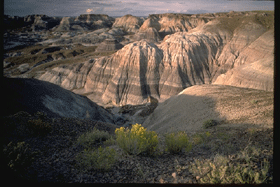
The National Park System wants to add 28,000 acres to the Petrified Forest National Park but doesn’t have the funds to buy the surrounding land from a former rancher who wants to sell.
Credit: (National Park System)
TIPTON: Those kinds of facilities are available all around Valley Forge. We’re talking about suburban Philadelphia, 20-minute drive from downtown. The problem is, with a hotel and a conference center, is that that would be major development in what we would call ‘hallowed ground.’ This was part of the Continental Army’s encampment during the famous retreat to Valley Forge.
GELLERMAN: I want to ask you about Zion National Park, which I think is one of the most beautiful places in the country. There’s actually development going on there right now.
TIPTON: Yes. In fact, two years ago a very important piece of land in the middle of Zion National Park was purchased by a couple from California, and they defied the Park Service, who had a willingness to buy but no money, and built what is being called a mini-retreat but is actually a very large mansion on this property within the heart of the park.
GELLERMAN: One of the places that you want to buy up is in the Petrified Forest in Arizona. And that’s the largest one at what, 125,000 acres.
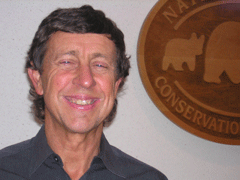
Ron Tipton, senior vice president of NPCA, says unless the federal government acts to protect America’s national parks, the country’s favorite places could face more commercial development.(Courtesy of NPCA)
Not a single acre of that land has been purchased in the last four years. The landowner of 28,000 acres, a big ranch, is willing to sell – in fact he’s not a willing seller, he’s a desperate seller. We’re estimating six million dollars is our current estimate to buy those 28,000 acres – but eventually that landowner is going to be forced to sell.
GELLERMAN: Well, he wants to sell – the Park Service wants to buy it.
TIPTON: Right.
GELLERMAN: What’s the problem?
TIPTON: Well, the problem is money. Basically, the Park Service needs about 100 to 150 million dollars a year, and the last several years it’s been getting 30 or 40 million dollars. A number of states – not just the big states like California and New York, but even smaller states like Maryland, where I live – usually spend more money each year on conservation of lands in their state than the National Park Service has available for the entire National Park system.
GELLERMAN: So, this is a question of allocating the resources.
TIPTON: Exactly. And you have a funding source, the Land and Water Conservation Fund that was established for this purpose. 900 million dollars a year is supposed to go to conservation and recreation lands from the Land and Water Fund.
That money comes from the royalties that are paid for offshore oil and gas leasing in the United States outer continental shelf and in the Gulf of Mexico. And, you know, the deal that was made 40 years ago was, we’re going to protect federal resources with some of those revenues – and the federal government is not fulfilling its end of the bargain.

Valley Forge National Park. Developers want to build a hotel, museum, and conference center on private land in Valley Forge.
(Courtesy of NPCA)
TIPTON: Those requests are from the Bush administration, and they have not championed this program, to say the least. America’s heritage is for sale, unfortunately, and private interests have the opportunity to buy it. It is for sale to the public through the National Park Service who should be the ones who purchase it. I mean, this is an amazing range of places of natural beauty, ecological importance, wildlife habitat, and history, culture and diversity that our National Park system represents.
GELLERMAN: Well, Mr. Tipton, I want to thank you very much.
TIPTON: Thank you, Bruce. My pleasure.
GELLERMAN: Ron Tipton is senior vice president of National Parks Conservation Association.
Related links:
- To read the NPCA report, click here
- National Park Service
- National Parks Conservation Association
Our Sound Environment
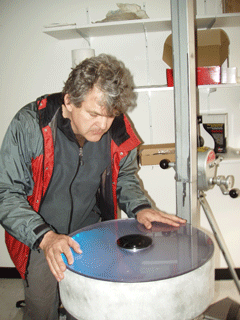
Sound artist Bruce Odland at the "sound dial" for his upcoming installation, "Harmony in the Age of Noise." (Photo: Jackson Braider)
GELLERMAN: Now, from nature to noise.
[JACKHAMMER, VEHICLE ENGINES]
GELLERMAN: Modern life can get loud.
[JACKHAMMER, ENGINES]
GELLERMAN: We live in a complex sea of sonic information. But what is noise and what is art is in the ear of the listener, according to soundscape composer Bruce Odland.
ODLAND: I like to think that when we screen out all those amazing sounds, we’re doing a huge amount of work. It really costs us a lot of our brainpower to filter out these sounds around us. And it costs us health-wise, and it costs us economically, and it costs us in separation from nature to filter out all those noises, and to take this incredible sense of hearing and instead of using it to find out what’s going on, to use it to pretend nothing’s going on.

Students mapping the sonic details of their environment. (Courtesy of Bruce Odland)
[STUDENTS WORK ON CONSTRUCTING “HARMONY IN THE AGE OF NOISE”]
ODLAND: It makes sense to work with an anthropologist because we’re culturally complicated people and our senses are really part of us, they’re packaged. We ended up with this whole bundle of senses as hunter-gatherers, and we still have them in our ears – we still have hunter-gatherer hearing.
This project is all about capturing and resurrecting that fine, incredible sense of hearing. We just have to use it to decode the noise we make as a culture.
GELLERMAN: So, the idea of Harmony in the Age of Noise is to actually let, let the sounds flow, let ‘em in.
ODLAND: Yeah, the idea is to get a balance between the senses, to not let the visuals override your acoustic awareness – actually get a harmony of your own senses, that they’re balanced, that they’re not insanely visual to the cost of all the other senses. And to pay attention, and to not filter out but to actually actively go out and find out what are the sounds around us and what they mean.
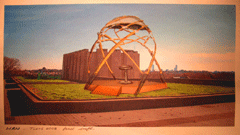
Image from the tuning tube at the "Main Drag" which plays Boston Avenue in the key of "E" in real time over the Internet. (Courtesy of Bruce Odland)
ODLAND: We’re trying to create a perfect sound shape here, so that everything is right with your ears; everything is tuned to the sense of hearing.
[SOUND OF PASSING TRAIN]
GELLERMAN: So, you’re going to construct this – oh boy. Boy, that’s a big sound. What was that?
ODLAND: That’s the fast-moving train headed out from Boston, echoing into this empty loft space that we’re working in, so the loft is the filter for the train.
GELLERMAN: You could use that in the, in your harmony.
ODLAND: Yeah, let’s do that.
[SOUND OF PASSING TRAIN; DOOR SQUEAK; FOOTSTEPS ON STAIRS]
GELLERMAN: Footsteps echo in the stairwell of the vast decrepit building on the Tufts campus.
[FOOTSTEPS WALKING UP STAIRS]
GELLERMAN: Alright, so we just went up a bunch of stairs here, we’re coming – boy, what was this place before?
ODLAND: This was some kind of medical scientific laboratory.

The sound dial. (Courtesy of Bruce Odland)
GELLERMAN: Here where students once huddled over Bunsen burners and test tubes, they’re helping Bruce Odland realize his sonic vision.
ODLAND: And we’ve got sort of like some kind of 1960’s Dr. No set that’s been abandoned by the actors.
[STUDENTS CONSTRUCT “HARMONY IN THE AGE OF NOISE”]
GELLERMAN: It’s an apt description, a case of art imitating a movie. In the 007 film, the diabolical Dr. No uses a gigantic parabolic mirror to focus powerful solar rays. In “Harmony in the Age of Noise,” workers are building a huge parabolic collector to focus sound waves. The collector will be mounted atop a giant gazebo, and the gazebo will be erected outdoors atop the Tufts library.
ODLAND: So when you walk into the gazebo, it’s like being in a four channel set of headphones, but you don’t have to wear anything that separates you from the environment.
GELLERMAN: So, you take the gazebo…and what do you do with it?
ODLAND: Yeah, in the gazebo is going to live this fantastic piece of technology that we’ve come up with for this project called the sound dial. You can think of it as sort of like the steering wheel to a spaceship. When you put your hands on the dial and point it in a certain direction, you start to teleport the sounds from that direction into the four speakers. So, think of it as a psychoacoustic map where, that you’re standing right in the middle of, with a giant compass, and you lay your hands on this compass to activate it, and you point it at something, and it starts to tune into that thing, and brings you sounds and images from that thing that have been collected by 50 or 60 different Tufts students.

Sound artist Bruce Odland at the "sound dial" for his upcoming installation, "Harmony in the Age of Noise." (Jackson Braider)
[CONSTRUCTION SOUNDS FROM LOFT AT TUFTS]
ODLAND: We’ve got the sound dial here. Let me lower it for you here so you can get a good look at it.
[FOOTSTEPS, JOINT CREAKS]
GELLERMAN: I’m not sure, how would I describe this? It looks like one of those, uh, Van de Graaff generators.
ODLAND: It looks like something Tesla might have built, doesn’t it?
ODLAND: When you first walk up to it, it’s going to be basically chanting like a didgeridoo. What that is – is what we call the main drag. We put a tube of 14 feet in length, and a little webcam, and that tube is reporting to the parabolic shape here. And we’re hearing it in real time. And when you walk up to it, the whole world is tuned to the key of E. All the harmonics get regenerated, and it makes a chord – basically Boston Avenue is playing a huge didgeridoo.
[REAL-TIME SOUND FROM 14 FOOT TUBE SUSPENED OVER BOSTON AVENUE AT TUFTS]
ODLAND: I point this dial over at Eaton Hall, for instance, we can start to go into the maps the students have made of Eaton Hall – the computer terminals being clicking and clacking. Or if it point it over towards the gymnasium – this guy thought it was a great idea to go and get the atmosphere of the swim team practicing – what kind of acoustic that is.
[SWIM TEAM PRACTICING IN POOL AT TUFTS]
ODLAND: So this project called ‘Harmony in the Age of Noise” is seeking a balance, seeking a new balance, seeking some harmony, finding elements of beauty in this massive soundscape we made accidentally. Elements of truth in it, elements of reckoning, for instance. And putting it all in one interactive installation where people can come and explore and have their ears opened.
As a matter of fact, your listeners can give us sounds, too, and if they’re out there and recording, and they want to participate, they can. Part of this gazebo is going to have a sort of a bell tower function. So on the hour, every hour, volunteer sounds from the outside world loaded in from the web can be put there, and say – for instance, next Wednesday at 3 am I want my sound to come out, yeah, go to our website and put it up there, and then come on down and listen to your sound.
[SOUND FROM THE TUBE SUSPENDED OVER BOSTON AVE.]
GELLERMAN: Well, Bruce Odland, thank you very much. I really appreciate your time.
ODLAND: You’re very welcome.
GELLERMAN: Composer Bruce Odland and anthropologist David Guss’s installation, “Harmony in the Age of Noise,” launches on April 23rd. For photos and more information check out our website, L-O-E- dot org. Our story was produced by Jackson Braider with help from Margaret Rossano.
[CHANTING SOUNDS FROM THE TUBE SUSPENDED OVER BOSTON AVE.]
Related link:
Harmony in the Age of Noise
GELLERMAN: Living on Earth is produced by the World Media Foundation. Our crew includes Ashley Ahearn, Bobby Bascomb, Eileen Bolinsky, Ingrid Lobet, Helen Palmer, Mitra Taj and Jeff Young, with help from Jennifer Baessler, Sarah Calkins and Jackson Braider.
Our interns are Annie Jia and Margaret Rossano. Jeff Turton is our technical director. Alison Lirish Dean composed our themes. Steve Curwood is our executive producer. You can find us at LOE dot org. I’m Bruce Gellerman. Thanks for listening.
ANNOUNCER1: Funding for Living on Earth comes from the National Science Foundation, supporting coverage of emerging science, and Stonyfield Farm – organic yogurt and smoothies. Stonyfield pays its farmers not to use artificial growth hormones on their cows. Details at stonyfield.com. Support also comes from you our listeners, the Ford Foundation, the Town Creek Foundation, the Oak Foundation, supporting coverage of climate change and marine issues and Pax World Mutual Funds: socially and environmentally sustainable investing. Pax World: for tomorrow. On the web at paxworld.com.
ANNOUNCER2: PRI, Public Radio International.
Living on Earth wants to hear from you!
Living on Earth
62 Calef Highway, Suite 212
Lee, NH 03861
Telephone: 617-287-4121
E-mail: comments@loe.org
Newsletter [Click here]
Donate to Living on Earth!
Living on Earth is an independent media program and relies entirely on contributions from listeners and institutions supporting public service. Please donate now to preserve an independent environmental voice.
NewsletterLiving on Earth offers a weekly delivery of the show's rundown to your mailbox. Sign up for our newsletter today!
 Sailors For The Sea: Be the change you want to sea.
Sailors For The Sea: Be the change you want to sea.
 The Grantham Foundation for the Protection of the Environment: Committed to protecting and improving the health of the global environment.
The Grantham Foundation for the Protection of the Environment: Committed to protecting and improving the health of the global environment.
 Contribute to Living on Earth and receive, as our gift to you, an archival print of one of Mark Seth Lender's extraordinary wildlife photographs. Follow the link to see Mark's current collection of photographs.
Contribute to Living on Earth and receive, as our gift to you, an archival print of one of Mark Seth Lender's extraordinary wildlife photographs. Follow the link to see Mark's current collection of photographs.
 Buy a signed copy of Mark Seth Lender's book Smeagull the Seagull & support Living on Earth
Buy a signed copy of Mark Seth Lender's book Smeagull the Seagull & support Living on Earth

